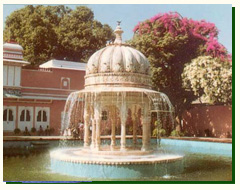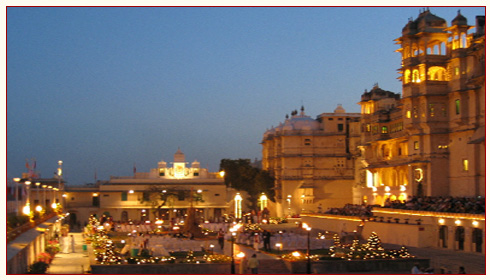The beautiful city of Udaipur was founded in 1567 and used to be the capital of
the former
princely state of Mewar. Situated at the shore of two lakes – Lake Pichola and Fateh Sagar- it is also called “Venice of the East”.
Surrounded by the lush green hills of the Aravalli Mountains, the city is one of the most romantic towns is India and unlike every other place in Rajasthan. Countless poets, writers and painters were and still are inspired by its white splendour. The old city is a labyrinth of narrow lanes, old havelis, palaces and temples. While walking through it, Udaipur's glorious past seems just a moment away. Founded by Maharana Udai Singh in 1567, Udaipur is the jewel of Mewar, a kingdom ruled by the Sisodias for more than 1200 years. After a long war with the Muslim rulers of Delhi, the old capital Chittor was not safe anymore, so the Sisodia rulers decided to found a new capital, further south. Hence Udaipur came into being.
|
The city is still dominated by the vast City Palace complex, situated on a hill on the eastern shore of Lake Pichola. The construction started in 1567, but many parts were added in later centuries. The appearance however is surprisingly consistent. Today the City Palace of Udaipur is the largest palace complex in India. It houses a museum, luxurious hotels, a school and the residence of the descendant of the last king of Udaipur.
In former times, a city wall encircled the whole city of Udaipur. Today only 8 out of formerly 11 city gates and small parts of the fortification are left. The city has long since outgrown its former barrier and has
at present
a population of 3,50,000 people.
|
| |
|
Known in the whole world is the famous Jag Niwas , or Lake Palace. The former summer palace of the king, built on an island in Lake Pichola, has been converted into a luxurious hotel, managed by Taj Group. Among many other celebrities, Queen Elizabeth and Jacky Kennedy stayed there. In 1982 the James-Bond-movie “Octopussy” was partly shot in Lake Palace.
The second island in Lake Pichola is called Jag Mandir . Another smaller palace was built there by Maharana Karan Singh, which served mainly as a guesthouse. It is said, that it served as an inspiration for the Taj Mahal, which however is not proven. Nevertheless Shah Jahan, the builder of it, stayed on Jag Mandir from 1623-1624, as a personal guest of the Maharana. |
| |
The rulers of Udaipur took great care that the city was always green and cool. For this purpose they constructed a number of gardens. Most of them survived and still fulfil their function. On the weekends numerous families flock to Gulab Bagh (rose garden) or to Sahelion-ki-Badi (garden of the maidens) in order to enjoy the greenery and have a family picnic.
The largest and most beautiful of the old havelis or townhouses is the Bagore-ki-haveli , situated at Gangaur Ghat. Facing the Pichola Lake, it used to be the house of one of the most influential families of Udaipur. It was built in the 18 th century by the prime minister of Mewar state. Today it houses a very interesting museum and hosts many cultural functions and events.
|

|
| |
|
About 5 km outside Udaipur is Sajjan Garh or Monsoon Palace, situated. Built on top of a hill overlooking Fateh Sagar Lake, it dominates the skyline of Udaipur and is visible from a great distance. Maharana Sajjan Singh started its construction in the 19th century, but the palace was never completed. The Maharana died before the termination and his successor had no interest in spending more money on it.
Today it belongs to the government and hosts a wildlife exhibition. The area around was declared a natural sanctuary in 2002. Every evening many tourists go up to Sajjan Garh in order to enjoy the views and admire the sunset. |
| |
Eklingji (22km): The place of the beautifully sculptured temple of the royal family. Built in 734, it is dedicated to Lord Shiva.
Nagda (23km): Another worth-seeing temple site. The Sas-Bahu (Mother-in-law & daughter-in-law) temple dates back to the 9 th century. Due to its exquisite carving this temple is also called Little Khajurao.
Haldi Ghati (40km): The site of the famous battle of Haldi Ghati, which was fought in 1546 between Maharana Pratap and the Mogul emperor Akbar. Here the Chetak Chattri is situated. A recently erected museum tells the story of Maharana Pratap and Chetak. The surrounding landscape is very attractive. |
|
Jaisamand Lake (48km): The second largest man-made lake in Asia is stunningly situated amid green hills. Constructed already in the 17 th century by Maharana Jai Singh, it provides the city of Udaipur with drinking water. Situated in the chief tribal region of Rajasthan, it is a wildlife sanctuary and protection area. On top of the hills surrounding the lake are the two former summer palaces of the queens of Udaipur.
Molela (30 km): A picturesque village famous for its pottery.
|
| |
Kumbhalgarh (84km): The second-most important fort of the former state of Mewar is perched high up in the Aravalli Mountains. It was the place of retreat for the kings in times of danger. Built in the 15 th century by Maharana Kumbha, it was captured only once in its history, and even then it needed the combined force of Moghul emperor Akbar, Amber (Jaipur) and Marwar (Jodhpur).
A 36km long wall on which 5 horses can gallop next to each other surrounds it. Today the mountain around Kumbhalgarh are declared a wildlife sanctuary, famous for its wolfs. |
|
| |
Ranakpur (60 km): The biggest and most famous Jain temple of Rajasthan is situated in this small village in the middle of the Aravalli Mountains. The main temple was built in 1439 and was dedicated to the tirthankara Adinath. It has 29 halls, supported by 1444 pillars, each carved out of marble with a distinctive design.
Chittorgarh (110km): The former capital of Mewar and its most important fortress is a historically most significant and interesting place. Chittorgarh is a symbol of the valour and the chivalry of the Rajputs. It was captured three times in its history and every time the men rather died in the battlefield than surrender to the enemy. They donned yellow robes and rode out in order to die by the sword. The women inside committed
jauhar
, collective suicide, by burning themselves on a pyre.
Today the fort lies in ruins, but still its long lost splendour and majesty can be perceived. |
| |
|
| |
|


